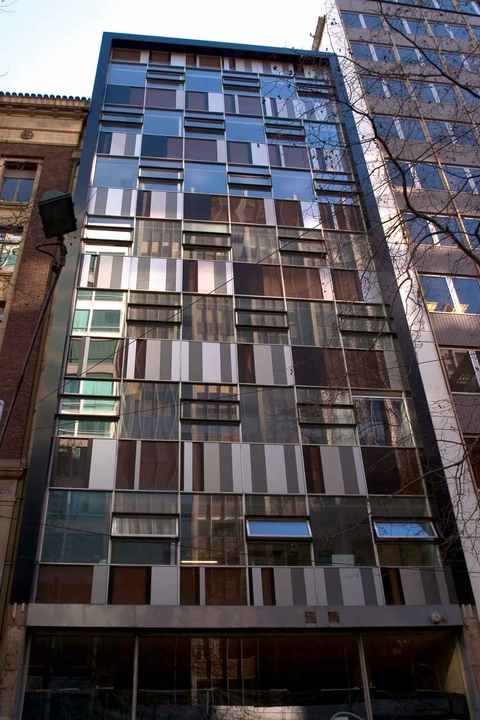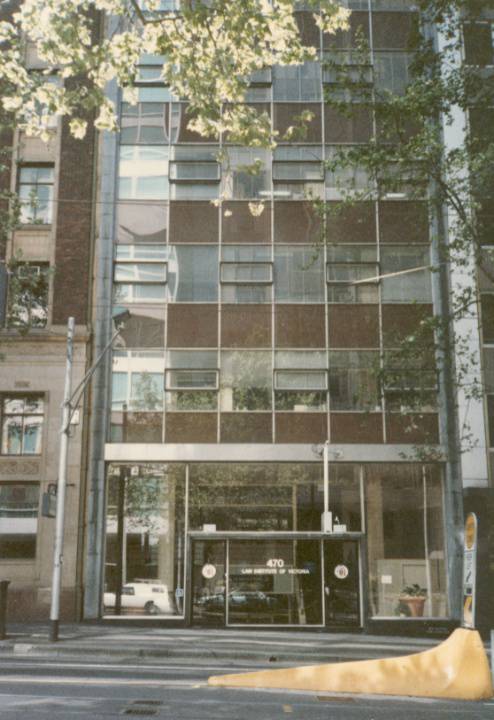| Back to search results » | Back to search page » |
|
Former London Assurance
Other NameLaw Institute Of Victoria Location468-470 Bourke Street,, MELBOURNE VIC 3000 - Property No B6567
File NumberB6567LevelRegional |
|
Statement of Significance
STATEMENT OF CULTURAL HERITAGE SIGNIFICANCE:
What is significant? The building was constructed in 1959 as the new Australian headquarters of London Assurance, a UK based insurance company. It was designed by Bernard Evans, a Melbourne architect with a long career, who was also Melbourne City Councillor for many years in the 1960s, and 70s and was an outspoken mayor in the early 1970s. In 2003 the facade was modified to a design by H2o architects.
It is a simple curtain-walled office block, a type very typical in Melbourne in the mid to late 1950s, when there was a construction boom following the lifting of post WWII building material restrictions in 1953. It is a reinforced concrete structure, with party walls on both the side boundaries, metal-framed windows on the rear (north) facade, and a curtain wall on the street (south) facade. This curtain wall is the most notable feature of the building, and differs from other curtain walled offices of the period with the incorporation of 'hopper' windows, which are sections of the window that are openable, independently framed in black aluminium, against the natural aluminium of the rest of the curtain wall. These hopper windows are also placed in a pattern in the facade, at every second window, a position which alternates on each floor. The ground floor 'shopfront' facade is also largely intact, and is one of the few remaining in office buildings of this period in the city.
The alterations of 2003 included the covering over of the dark grey terrazzo edging, which had decayed, with black aluminium cladding. The dark brown coloured-glass spandrel panels were also partly covered with removable coloured aluminium cladding in various shades of grey, leaving 40% of the original visible. A new sliding glass door replaced the original doors within the black terrazzo portal frame of the street facade. The foyer is largely intact, with its unusual arrangement of a pair of stairs, one leading up, and the other down, a half level each. The lift lobby, the side walls and a pair of columns are clad in travertine, with some inlaid black granite and gold mosaic tiled strips, the stair treads are in black granite, edged with black marble, and the balustrades are black metal rods, topped with brass handrails. The floor in front of the entrance doors and the lifts is white marble, similar to the original, reinstated in 2003.
How is it significant? The Former London Assurance building is significant for architectural reasons at a Regional level.
Why is it significant? The former London Assurance building is architecturally significant for its use of hopper windows, placed in a rhythmic pattern in the curtain walling, a distinctive variation for city offices of the 1950s, and the only one remaining in the city. The ground level and lobby are also finely and unusually detailed, incorporating a large expanse of glass 1 1/2 floors high, creating a large transparent screen allowing views into the lobby, and its unusual arrangement of upper and lower levels. It is also notable that the ground floor facade and lobby areas are largely intact, since virtually all other examples in the city have been completely altered.
The alterations of 2003 have only slightly altered the elements of significance. The new cladding is reversible, and gives the facade an interesting contemporary overlay, while allowing a significant proportion of the original spandrels to remain visible.
Historically, it is one of the best works surviving by successful commercial architect and civic leader Bernard Evans. A designer of many buildings over a long career, notable projects include Tudor Revival style shops in Toorak Village, and the famous 'London Court' arcade in Perth of the 1930s, the Ampol Building in South Carlton of 1959, and the CRA Tower of 1962 at 95 Collins Street, once the city's tallest but demolished in 1989. He was a Melbourne City Councillor for 23 years, Lord Mayor 1958-60, helped to introduce strata-titling and was a champion for the creation of the city Square, and was knighted in 1962.
Classified: 17/05/2004
Group
Government and Administration
Category
Office building





